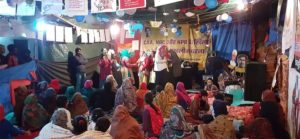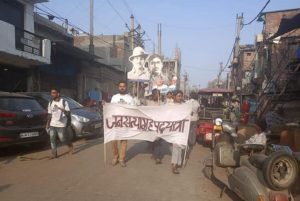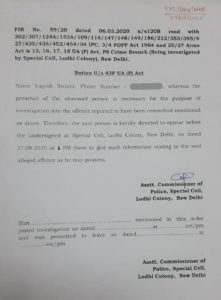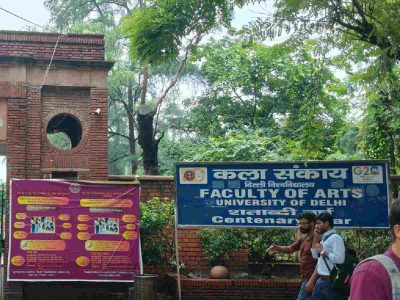Linking the protests to Delhi riots, police are going after four labour rights activists who were summoned between April and August, and were asked who had ‘funded’ the citizenship law protest in Khajuri Khas area
In the last five months, the Delhi police’s special cell has summoned at least four labour activists to question them about the citizenship law protests organised in Khajuri Khas in January and February this year. The summons appear to be part of the police’s attempt to link the citizenship law protests with the riots in February that left over 50 dead.
Khajuri Khas was among the areas worst affected by the violence, with mobs chanting “Jai Shri Ram” slogans torched several buildings.
The four activists are Yogesh Swamy, 38, Vishal Kumar, 26, Sunny Singh, 31, and Rakesh Kumar, 30. In an exclusive conversation with Newslaundry, they said the police’s line of questioning revolved around a road blockade that had been set up by the protesters in Chandbagh, and the “funding of the anti-CAA protests”.
Yogesh, Vishal, Sunny and Rakesh are members of the Bigul Mazdoor Dasta, a leftist organisation that works on issues of the workers in the informal sector. All four were summoned between April and August.
Yogesh is also the vice-president of the Naujawan Bharat Sabha, an organisation that professes to follow the ideals of freedom fighters Bhagat Singh, Sukhdev Thapar and Shivaram Rajguru. After February’s violence, the Naujawan Bharat Sabha distributed relief material in Karawal Nagar, near Khajuri Khas.
Vishal, an artist, had visited protest sites in Shaheen Bagh and Jamia Millia Islamia University in December 2019 to make posters and graffiti. Sunny and Rakesh have been organising protests and raising concerns about the safety of workers in industrial units in Bawana, Wazirpur and Jhilmil. Sunny has a PhD in quantum mechanics and is looking to be a lecturer and Rakesh gives tuitions for a living.
The Naujawan Bharat Sabha, along with the Bigul Mazdoor Dasta, had organised a sit-in demonstration against the citizenship law and the National Register of Citizens in Khajuri Khas in late 2019. The Bigul Mazdoor Dasta had also organised protests in January and February, and the four activists helped make the arrangements.

Sources familiar with the investigation told Newslaundry that the police have identified 26 spots, mostly Muslim-dominated areas, across Delhi that were sites of anti-CAA protests. The police officials are trying to connect the dots whether those involved in road blockades, in a bid to draw the attention of US president Donald Trump who was visiting at the time, were also the ones who started the violence in February.
Protests, peace marches, and summons
On January 16, members of the Bigul Mazdoor Dasta organised a sit-in against the citizenship law at Rahman Chowk in Khajuri Khas. After differences of opinion with members of political parties, Sunny said, he and his colleagues shifted the sit-in to Jama Masjid in Khajuri Khas.
In the second or third week of February, the four activists organised a Jan Satyagraha Padyatra, from Narela to Bhalswa in northwest Delhi, and from Khajuri Khas to Inderlok in northeast Delhi. The padyatra was held to discuss issues such as poverty and housing for all and to demand a National Register of Unemployed. Soon after the Delhi carnage, they took out peace marches until March 4 and aided in the formation of Aman Committees, or peacekeeping groups.
Yogesh was summoned first on April 16 and then on April 17 by the special cell. He was told to report to the Lodhi Road office of the special cell at 6 pm on the same day, and was questioned for five or six hours. He was summoned again on August 27.
Vishal was summoned on April 18 and 19. His mobile phone was seized and hasn’t been returned yet. Like Yogesh, he was summoned again on August 27, and they were questioned together for about 15-20 minutes after being made to wait for three hours.

Rakesh was summoned on April 17 and questioned for two hours, and Sunny on June 12.
All four were asked about who made speeches at the Khajuri Khas protest site. Prominent speakers had included poet Gauhar Raza and activist Shabnam Hashmi.
“I was asked whether I’m familiar with Pinjra Tod members,” said Yogesh, referring to the women’s collective whose activists were accused of being involved in the carnage and arrested under the anti-terror law, the Unlawful Activities Prevention Act.
“They asked whether the Pinjra Tod members visited the Khajuri Khas protest site,” Yogesh added. He was also asked whether he knew Safoora Zargar, the Jamia Millia Islamia student who was arrested in April.
On hearing their names, both Yogesh and Rakesh said, an investigating officer asked: “Why did you visit the protest site? What was your problem?” This indicated that the officer believed the citizenship law protesters were predominantly Muslim.
Sunny was interrogated for two hours and was asked about the protests at Khajuri Khas and Chandbagh. “We told them, ‘Haan, shamil hue the.’” Yes, we did participate.
He was also asked who took the call to organise the road blockade in Khajuri Khas. Other questions included: how much money was spent in organising the protests? Where did the funding come from? Where was food procured from for the protest site? Who made arrangements for blankets at night?
FIR No. 59
Yogesh, Sunny, Vishal and Rakesh were sent summon notices that referred to FIR No 59/2020 filed on March 6. The notices were issued under Section 43(F) of the UAPA and said: “Presence of the aforesaid person is necessary for the purpose of investigation into the offence reported to have been committed.”
FIR No 59/2020 is the FIR on the basis of which Jamia Islamia students Safoora Zargar and Meeran Haider had been arrested. Zargar was released in June on “humanitarian grounds”, but Haider is still in jail.
Interestingly, FIR No. 59/2020 was registered by the Crime Branch police station in Delhi on the basis of a complaint by a sub-inspector. According to the Wire, the FIR said the Delhi riots were “part of a preplanned conspiracy…hatched by JNU student Umar Khalid and his associates who are linked to a number of organisations.”
In August, Delhi University professor Apoorvanand was questioned for five hours in connection with allegations made under the same FIR. The two Pinjra Tod activists, Natasha Narwal and Devangana Kalita, were arrested in May under a different FIR, but were then rearrested under FIR No. 59.
Around 750 FIRs have been filed by the Delhi police in connection with the riots. But it’s only FIR No. 59 that has been filed under the UAPA.
“This is a false and concocted FIR under the UAPA,” said Mahmood Pracha, a lawyer representing some of the citizenship law protesters and victims of the Delhi riots. “The police do not have any evidence. The basic idea is to scare away people from protesting again. There is not an iota of evidence against anyone.”
He added: “A police official filed a complaint on the basis of a secret informer, which makes it open to hearsay, because that secret informer will remain a ghost.”

Police theories
Summons to Yogesh and Sunny may have been based on the statement of Shadab Ahmad, a citizenship law protester, to the police while in police custody. A statement given by an accused in police custody has no evidentiary value in law as per legal experts.
According to the Wire, Shadab, a resident of Bijnor, Uttar Pradesh, has told the police about two WhatsApp groups that planned to set up, among other things, roadblocks to give the protests an “offensive” character.
Yogesh said he had met Shadab at Shaheen Bagh. “He knew that we were the organisers of the sit-in at Khajuri Khas,” he said.
The Delhi police are currently relying on testimonies like Shadab’s to establish that the anti-CAA protests laid the groundwork for the violence in February. This feeds into the police’s narrative that Muslims led the violence during the carnage even as eyewitnesses have alleged that their police statements were fabricated.
As activist Harsh Mander said at a virtual press conference last week, “The complicit and partisan role of the police is central to understanding the conspiracy behind the violence…The Delhi police wants to show to the world that nobody is going to question us. Hundreds have been called by the police and now they are forcing people to become approvers.”
Update: This piece has been updated to clarify that Shadab Ahmed is a citizenship law protester who made his statement to the police while in police custody.
www.newslaundry.com





